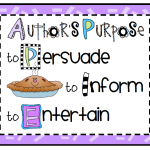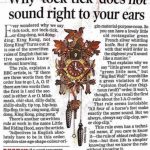Author’s Purpose: Why should we care?
 Questions about the writer’s purpose appear on virtually every reading test and we often teach students the acronym PIE: Persuade, Inform or Entertain. But why does it matter?
Questions about the writer’s purpose appear on virtually every reading test and we often teach students the acronym PIE: Persuade, Inform or Entertain. But why does it matter?
Several years ago, I was involved in a reading assessment that required Grade 5 students to read and answer questions about a silly poem called “Michael Built a Bicycle” by Jack Prelutsky. In the poem, Michael puts everything – including the kitchen sink – on the bicycle, but forgets to add a seat and pedals. When asked the ubiquitous question about the author’s purpose, a disappointing number of students thought the poem was intended to teach readers how to build a bicycle.
Those readers obviously missed the intended humour of the piece, as well as the irony of a bicycle equipped with everything under the sun except the equipment needed to actually ride it. But also, anyone actually reading the poem to find out how to build a bicycle would be sorely misled.
Understanding the author’s purpose helps readers understand what a text is about. It guides us in taking a stance as readers. When we read the classic words, “Once upon a time,” it sets us up to be entertained by an old tale. When we read, “Hippos are the world’s most dangerous animal,” we’re prepared to be informed about what makes them so dangerous.
Identifying the author’s purpose also helps us recognize the techniques the writer has used to achieve that purpose: word choice, style, tone, and, of course, content. It guides us in considering that the author might have biases, experiences or opinions different than our own, and viewing the text through those lenses.
One way to help students understand author’s purpose in reading is to get them thinking about audience and purpose when they write. Read more about Purpose, Perspective and Point of View and get a set of quick and easy prompts to practice writing about the same topic for different purposes.




